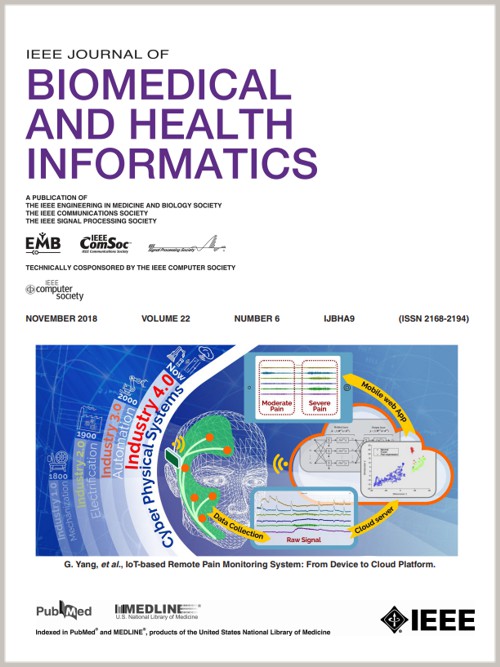Multi-Task Adaptive Resolution Network for Lymph Node Metastasis Diagnosis From Whole Slide Images of Colorectal Cancer
IF 6.8
2区 医学
Q1 COMPUTER SCIENCE, INFORMATION SYSTEMS
IEEE Journal of Biomedical and Health Informatics
Pub Date : 2024-10-24
DOI:10.1109/JBHI.2024.3485703
引用次数: 0
Abstract
Automated detection of lymph node metastasis (LNM) holds great potential to alleviate the workload of doctors and reduce misinterpretations. Despite the practical successes achieved, effectively addressing the highly complex and heterogeneous tumor microenvironment remains an open and challenging problem, especially when tumor subtypes intermingle and are difficult to delineate. In this paper, we propose a multi-task adaptive resolution network, named MAR-Net, for LNM detection and subtyping in complex mixed-type cancers. Specifically, we construct a resolution-aware module to mine heterogeneous diagnostic information, which exploits the multi-scale pyramid information and adaptively combines multi-resolution structured features for comprehensive representation. Additionally, we adopt a multi-task learning approach that simultaneously addresses LNM detection and subtyping, reducing model instability during optimization and improving performance across both tasks. More importantly, to rectify the potential misclassification of tumor subtypes, we elaborately design a hierarchical subtying refinement (HSR) algorithm that leverages a generic segmentation model informed by pathologists' prior knowledge. Evaluations have been conducted on three private and one public cancer datasets (554 WSIs, 4.8 million patches). Our experimental results demonstrate that the proposed method consistently achieves superior performance compared to the state-of-the-art methods, achieving 0.5% to 3.2% higher AUC in LNM detection and 3.8% to 4.4% higher AUC in LNM subtyping.从大肠癌全切片图像诊断淋巴结转移的多任务自适应分辨率网络
淋巴结转移(LNM)的自动检测在减轻医生工作量和减少误诊方面具有巨大潜力。尽管在实践中取得了成功,但有效处理高度复杂和异质的肿瘤微环境仍然是一个开放和具有挑战性的问题,尤其是当肿瘤亚型相互交织且难以划分时。本文提出了一种多任务自适应分辨率网络(MAR-Net),用于复杂混合型癌症的 LNM 检测和亚型划分。具体来说,我们构建了一个分辨率感知模块来挖掘异构诊断信息,该模块利用多尺度金字塔信息并自适应地结合多分辨率结构化特征以实现综合表征。此外,我们还采用了一种多任务学习方法,同时处理 LNM 检测和亚型分析,从而降低了优化过程中模型的不稳定性,并提高了这两项任务的性能。更重要的是,为了纠正潜在的肿瘤亚型分类错误,我们精心设计了分层亚型细化(HSR)算法,利用病理学家的先验知识建立通用分割模型。我们在三个私有和一个公共癌症数据集(554 个 WSI,480 万个斑块)上进行了评估。我们的实验结果表明,与最先进的方法相比,所提出的方法始终保持着卓越的性能,在 LNM 检测方面的 AUC 高出 0.5% 到 3.2%,在 LNM 亚型分析方面的 AUC 高出 3.8% 到 4.4%。
本文章由计算机程序翻译,如有差异,请以英文原文为准。
求助全文
约1分钟内获得全文
求助全文
来源期刊

IEEE Journal of Biomedical and Health Informatics
COMPUTER SCIENCE, INFORMATION SYSTEMS-COMPUTER SCIENCE, INTERDISCIPLINARY APPLICATIONS
CiteScore
13.60
自引率
6.50%
发文量
1151
期刊介绍:
IEEE Journal of Biomedical and Health Informatics publishes original papers presenting recent advances where information and communication technologies intersect with health, healthcare, life sciences, and biomedicine. Topics include acquisition, transmission, storage, retrieval, management, and analysis of biomedical and health information. The journal covers applications of information technologies in healthcare, patient monitoring, preventive care, early disease diagnosis, therapy discovery, and personalized treatment protocols. It explores electronic medical and health records, clinical information systems, decision support systems, medical and biological imaging informatics, wearable systems, body area/sensor networks, and more. Integration-related topics like interoperability, evidence-based medicine, and secure patient data are also addressed.
 求助内容:
求助内容: 应助结果提醒方式:
应助结果提醒方式:


